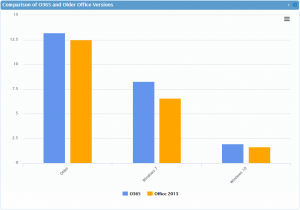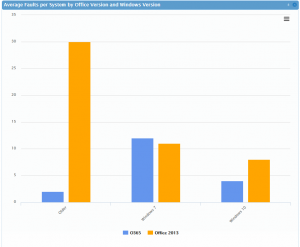How does Office 365 perform across Windows operating systems?

Modern users have the choice between a variety of Windows OS and Office versions. In relation to this mix, a common question we have come across in the past is “How does Windows 10 performance compare with Windows 7?” While we have addressed the situation in the past, it remains a popular question to this day. However, users are now becoming curious about the performance implications of Office versions against the operation systems. Through analysis of SysTrack Community data, we were able to reevaluate Windows 7 and Windows 10 performance implications against Office 365.
A feature that Windows 10 has is its integration with various components of Microsoft’s cloud portfolio. With this new component, we felt compelled to look at how Office 365 ran against past operating systems and how past versions of Office, specifically Office 2013, ran against current operating systems. Office 365 may look very similar to older versions, there are quite a few notable differences. While Office 2013 required a product key, Office 365 handles licensing more efficiently for users, potentially allowing each job role to be given a best fit licensing level.
This is just an example of how Office 365 is now closely reliant on the cloud. The cloud allows Office 365 applications to be available from any device and encourages collaboration among users while Office 2013 requires a local installation. Office 2013 did not allow for as smooth of collaboration, requiring the user to share files that have been saved locally or manually stored in a place that can be reached by others. Finally, with Office 365 being software-as-a-service, it has improved security and user experience by seamlessly providing small, frequent patches.
With all these updates to Office 365, how does it affect the overall performance characteristics? We ran a comparison of Office 365 against Office 2013 with different operating systems to see how their load times compared (displayed below in Figure 1).

While it is interesting that Office 365 seems to take a slightly longer time to load, it is mostly due to external connectivity and tying the user account context for Office 365 to the application itself. However, looking at application stability (displayed below in Figure 2), Office 365 has significantly fewer faults than Office 2013.

As displayed above, Office 365 faults significantly less in Windows 10 than Office 2013. This can be a result of both being “as-a-service” products ultimately resulting in less downtime users (thus a higher end user experience) and less maintenance for IT administrators. It can be concluded that while Office 365 takes a little more time to load, it is more stable than Office 2013 among the various operating systems.
So what does all this analysis mean? Ideally, Windows 10 and Office 365 should be used together to achieve high end user experience. Office 365, overall, is more stable providing less application faults. However, other operating systems are also compatible with Office 365 despite the slightly longer load time. To evaluate readiness for a Windows 10 migration, or performance monitoring, check out our free Windows 10 assessment, with the addition of SysTrack to provide the transparency of end user experience monitoring.
Subscribe to the Lakeside Newsletter
Receive platform tips, release updates, news and more



